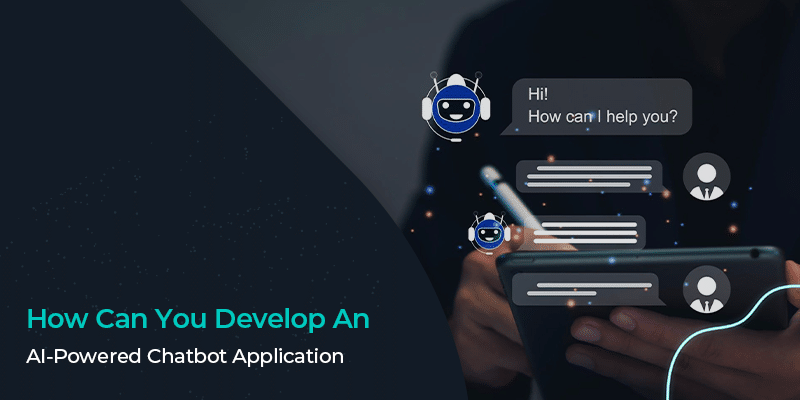AI has revolutionized the relationship between businesses and their customers. The rise of AI-powered chatbots represents an essential part of modern customer service which operates to optimize business operations and deliver superior user interactions.
The chatbots in these domains run twenty-four hours per day and decrease human workloads through enhanced speed of responses. The development of intelligent chatbots has become simpler because natural language processing (NLP) and machine learning (ML) methods continue to advance.
What Are The Main Steps To Create An AI-Powered Chatbot App
Identify The Function And Target Audience
All types of mobile app development work must halt until you define the essential goals and targets for your chatbot.
Ask yourself:
- Which functions does the chatbot serve?
- Which types of users will act as end users (businesses, customers, or employees)?
- What are the problems that your chatbot is going to solve for the users?
- What are the business goals and user needs that will guide development?
Choose The Right AI Technology
A chatbot achieves success through proper selection of its AI model which must align with both its functionality and complexity requirements. This might be easier through a proper app agency.
3 primary choices for chatbots are:
- Rule-Based Chatbots: Use predefined rules and decision trees, ideal for simple FAQ-based interactions.
- Retrieval-Based Chatbots: Obtain responses from pre-established databases to answer user inquiries.
- Generative AI Chatbot: exploits powerful NLP technology together with ML to create reactive dialogue responses.
Popular Chatbot Development Frameworks:
- Google Dialog flow
- Microsoft Bot Framework
- Rasa
- IBM Watson Assistant
To match the needs of your project determine the technology that offers the right fit between scope and complexity.
Select A Platform For Deployment
Determine the platform that will serve as your chatbot’s operational base.
- Web apps (e.g., company websites, SaaS platforms)
- Mobile apps (iOS, Android)
- Messaging platforms (WhatsApp, Facebook Messenger, Telegram, Slack)
- Voice assistants (Alexa, Google Assistant)
The platforms need unique APIs for integration as well as different user experience standards. Cross-platform compatibility must be verified when running your system on multiple platforms.
Design The Conversational Flow
- A bot’s delivery of natural interactions depends on a systematic layout of the conversation process.
- A flowchart or decision tree should demonstrate possible user interactions for creating rule-based chatbots.
- AI-powered bots need app developers to set user intention definitions known as intents while defining particular data points referred to as entities.
- A voice-based bot needs components for speech recognition and synthesis through TTS and ASR functionality.
A high-quality chatbot needs to perform basic conversation skills while guiding users between bot assistance and human support.
Train the AI Model
For NLP-based chatbot app development model training remains essential because it advances response accuracy levels.
Key steps:
- Dataset Collection – This contains a wide amount of conversational datasets for AI chatbot training.
- Data preparation (2 Parts): first clean all text while tokenizing it and then remove stop words before applying proper data formatting.
- Machine Learning Training – Deep learning techniques like LSTMs or Transformers can be used for deeper insights.
- Continuous Learning – You can use user feedback and new datasets to improve your chatbot over time.
Integrate With APIs And Databases
Mobile app developers need to understand that the complete advantage of a chatbot emerges through its connection to external data sources.
Essential integrations:
- Customer Relationship Management (CRM) – Collects data of users from platforms like Salesforce or HubSpot.
- Payment Gateways – Allow safe and easy transactions through Stripe or PayPal.
- E-commerce APIs – Shopping assistance integration are Shopify, Woo Commerce, or Magento.
APIs that deliver current weather conditions interact with maps and deliver news-based information to users are available.
Implement Security And Compliance Measures
Security takes priority status because chatbots manage user data.
Best practices:
- The complete encryption of user data protects it from breaches.
- Apply safe encryption techniques like OAuth and JWT to make your chatbot secure.
- Compliance with GDPR and HIPAA regulations must be maintained when dealing with individual data.
- Access mechanisms for content moderation and chatbot abuse prevention must be enabled.
With role-based access control (RBAC) installed chatbots gain the ability to block user access according to predefined authorization levels.
Test And Optimize For Performance
An experienced app development company performs thorough testing procedures to enable both error debugging and increased system performance for chatbots.
Testing strategies:
- Unit Testing – Thoroughly checks all the individual components of your chatbot.
- User Testing – Collect accurate user feedback through your chatbot responses.
- A/B testing – Evaluate numerous versions simultaneously to achieve optimal results.
- Load Testing – Allows the evaluation of system scalability when user traffic is at its peak.
Key metrics to monitor:
- The chatbot successfully interprets user queries through its accuracy measurement capabilities.
- User engagement can be found through the measurement of dialogue completion rates.
- The system detects mistaken or purposeless reactions through error rate measurements.
Choose analytics platforms such as Bo analytics combined with Dashbot or Google Analytics to evaluate your chatbot performance.
Conclusion
The development of an AI-powered chatbot demands strategic planning along with appropriate technology selection coupled with perpetual implementation improvements.



